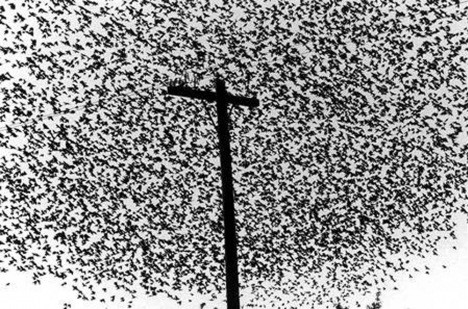Graciela Iturbide
13 May 2013 - 11 May 2014

Graciela Iturbide
Birds on the Pole, Guanajuato, Mexico 1990
Photograph, gelatin silver print on paper
Courtsey Jane and Michael Wilson
Birds on the Pole, Guanajuato, Mexico 1990
Photograph, gelatin silver print on paper
Courtsey Jane and Michael Wilson
Graciela Iturbide is widely acknowledged as one of the most important photographers working in Mexico today.
Beginning her photographic practice in 1969, Iturbide was mentored for many years by fellow Mexican photographer Manuel Álvarez Bravo before emerging from the independent photography movement of the 1970s. The works in this room represent an overview of her practice over four decades. Her subject matter varies considerably, but her primary concern has always been the depiction of everyday life inMexico, exploring themes of urban and rural life, indigenous rituals, the role of women, identity and the tensions between tradition and modernity.
In contrast to the objectivity conventionally associated with documentary practice, Iturbide’s works often result from a strong mutual relationship between subject and artist. This type of exchange can be seen most clearly in Iturbide’s work in traditional rural communities, which is based upon her building longstanding relationships with local people. In the southern Mexican region of Tehuantepec Isthmus, for example, she undertook a decade-long project in Juchitán, a small town known for its rare matriarchal social structure. Her stay produced some of her best-known images and culminated in the seminal photobook Juchitán of Women (1989). Although Iturbide produces the majority of her work in Mexico, this display also includes work from her more recent projects inIndia, Italy and the American states of Tennessee, Mississippi and Texas.
Graciela Iturbide was born in 1942 in Mexico City, where she lives and works.
Curated by Simon Baker and Shoair Mavlian
Beginning her photographic practice in 1969, Iturbide was mentored for many years by fellow Mexican photographer Manuel Álvarez Bravo before emerging from the independent photography movement of the 1970s. The works in this room represent an overview of her practice over four decades. Her subject matter varies considerably, but her primary concern has always been the depiction of everyday life inMexico, exploring themes of urban and rural life, indigenous rituals, the role of women, identity and the tensions between tradition and modernity.
In contrast to the objectivity conventionally associated with documentary practice, Iturbide’s works often result from a strong mutual relationship between subject and artist. This type of exchange can be seen most clearly in Iturbide’s work in traditional rural communities, which is based upon her building longstanding relationships with local people. In the southern Mexican region of Tehuantepec Isthmus, for example, she undertook a decade-long project in Juchitán, a small town known for its rare matriarchal social structure. Her stay produced some of her best-known images and culminated in the seminal photobook Juchitán of Women (1989). Although Iturbide produces the majority of her work in Mexico, this display also includes work from her more recent projects inIndia, Italy and the American states of Tennessee, Mississippi and Texas.
Graciela Iturbide was born in 1942 in Mexico City, where she lives and works.
Curated by Simon Baker and Shoair Mavlian
